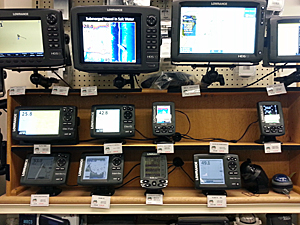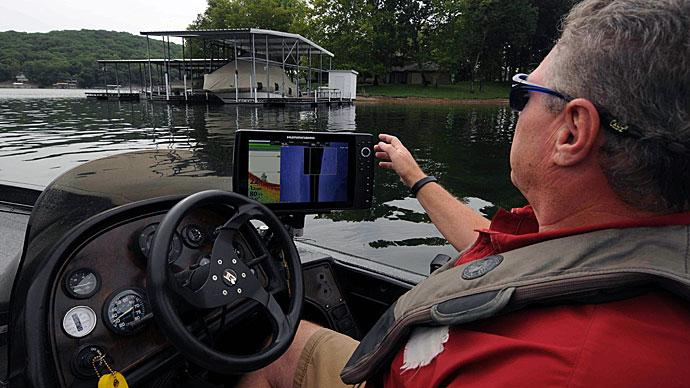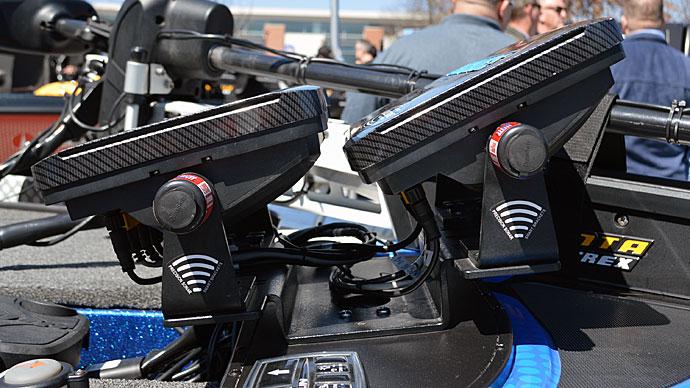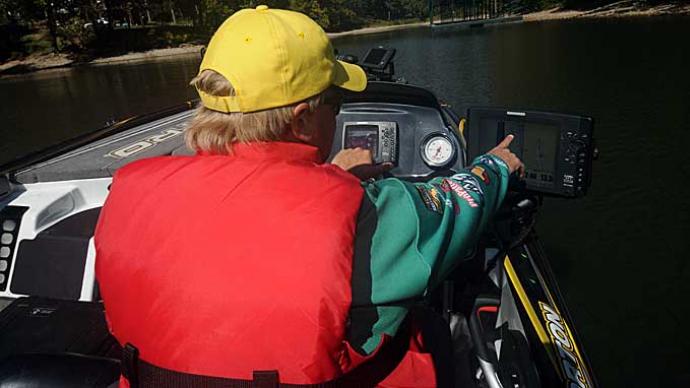
One of the critical elements of a fish-catching pattern is depth, and it is vital for fishermen to know the depth of the water beneath them. Knowing where the bottom is, dictates what type of lure you use. Even if you only "beat the banks" for bass, you will benefit from having a depthfinder mounted on your boat. Even more important, depthfinders will help you stay clear of dangerously shallow water when running the boat.
Depthfinders are sonar instruments that send a directional sound signal out from a transducer. The sound bounces off objects (the bottom, structure, and fish) and is received by the transducer, which transmits the impulse to the sonar unit. The depthfinder measures the elapsed time between sending the signal and receiving the echo and converts that information into depth reading in feet.
Keep in mind that the signal strength of the size of the return is not always relative to the size of the fish. Don't believe a depthfinder that shows different sizes of fish, it shows different signal strengths that can be misleading. For example, a fish that stays still shows up as a large fish whereas a big fish that zooms through the sonar signal appears as a small fish. If you are not familiar with interpreting a depthfinder, leave the unit on throughout your fishing day, studying it frequently. Whenever you catch a fish, note the depth and other information provided by the depthfinder. This will teach you the importance of depth in a fishing pattern. When you purchase a depthfinder, study the instruction manual carefully. Ask the salesman for additional instructions in interpreting the unit. Even better, spend some time on the water with a fisherman who is experienced in interpreting the kind of depthfinder you select.
The most advanced depthfinders "paint" a picture of the bottom and water beneath the boat by changing the colors of tiny pixels on an LCD screen. They have become extremely popular because they help an angler visualize the bottom and the position of fish near the bottom. The units usually are waterproof and durable, since these contain no moving parts to wear out. They range in sophistication from small, basic units that show the bottom, to large-screen information centers that can zoom in on fish, show water temperature, boat speed, engine diagnostics, and the hardness of the bottom. These extremely sensitive depthfinders even can show real-time 3-D images of the area around the boat. Most units include advanced GPS tracking and waypoint capabilities. Many serious deep-water fishermen consider these depthfinders essential in their pursuit of bass. But initial costs are higher than other depthfinders.
Tips
- When metering structure, always run the boat and depthfinder at the same speed every time (highest speed possible on our depthfinder). That way you can get used to knowing where the structure actually is when your boat moves over it.
- If you use a single depthfinder for both fishing and navigation, mount it on a swivel base that permits viewing from the bow of the driver's seat.
- A depthfinder used only in fishing should be mounted for easy view from the bow, and the transducer should be mounted on the base of the trolling motor.
- Bring the gain (sensitivity) up as high as you can without introducing "noise". You'll see more details, including the thermocline. Turn the sensitivity up as you get deeper and vice versa. Turn the fish symbol off and use the dots, you will see more details. Don't use suppressors unless you absolutely have to. You want your depthfinder to be as sensitive as possible.
- Visualize the underwater structure by "extending the shoreline" into the water.
- Use buoys to mark structure.
- Fish underwater structure like you would visible structure.
- The "bottom lock" feature on some units is good for split screen functions, but don't use it all the time. Otherwise you'll miss suspended fish and baitfish.
- Use epoxy or resin to attach the transducer to the inside of the hull - NOT silicone.
- On aluminum boats, mount the transducer on the transom, outside the hull, and in a position between rows of rivets. Otherwise, water turbulence when the boat is moving will interfere with the reading.
- Depthfinders are being upgraded as quickly as computers are. Select one that shows the greatest detail--that is, one with the smallest pixels and the largest number of pixels per vertical inch of screen.
- Look for fish activity and note their depth. They're probably not bass, but that's where all the activity is. Start fishing for bass at that depth.
- If you're depthfinder shows a ball of baitfish, analyze the form. A tight ball indicates they're being pursued by a predator fish. A loose ball indicates little activity.
- When using these types of units for metering slopes, scan uphill for a more accurate reading.
- Bear in mind that when you see something on the depthfinder that it may not be directly below the boat. It may be on the edge of the cone angle (i.e. it could be on the side of the boat).
- When purchasing a new unit don't buy a cheap one and then expect it to do a perfect job. Units can be purchased starting around $200 but are not very powerful and will only give marginal readings at high speeds. As a general rule, you should buy the best quality unit that you can afford but don't be concerned with features that you won't use. As with many boating accessories you get what you pay for and sometimes simple really is better. -- Robert Baldwin




